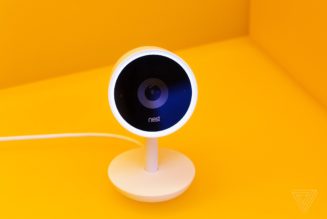I moved across the ocean and took my printer with me. Then I discovered it was region-locked. A wiser man would have bought a new one.
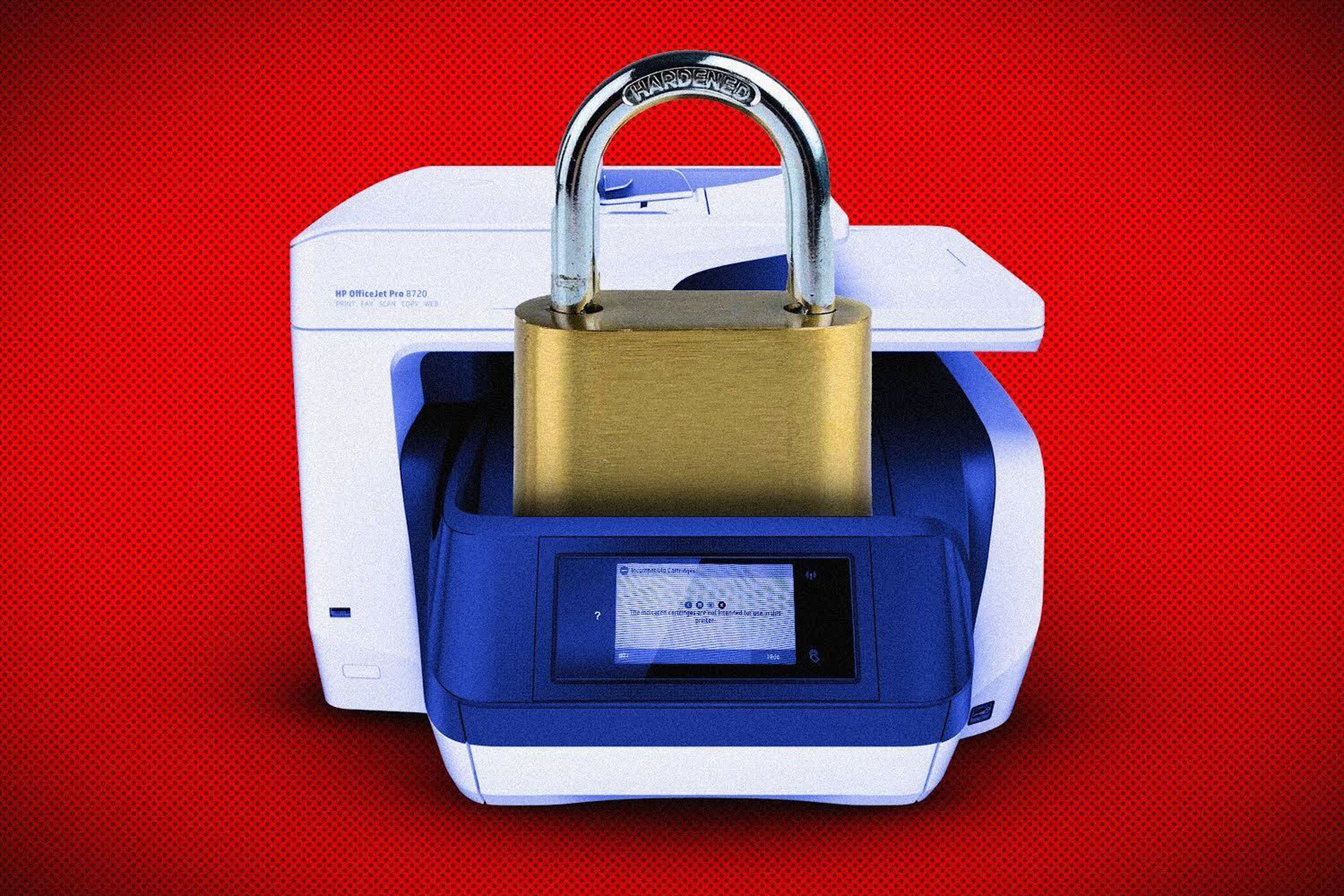
A couple of weeks ago, Nilay wrote about the Brother laser printer everyone else has. It’s cheap, reliable, and the toner lasts a long time. Get a Brother laser printer, he said, and basically never think about your printer again. You know what part of Nilay’s post sounded really nice? This part right here:
It has been connected to our Wi-Fi for like six years straight, and I have never replaced the toner. It prints Amazon return labels from my phone without complaining, and it does not feel like the CEO of Inkjet Supply and Hostage Situations Incorporated is waiting to mug me or enable DRM at the slightest provocation.
I, on the other hand, spent a couple dozen hours between September 2021 and February 2022 trying to defeat the region lock on my HP printer so I could go back to not thinking about it.
Hey, did you know most inkjet printers are region-locked?
Let me back up. In 2019, I was living in the Netherlands. I needed a printer, so I paid 192 euros (about $213 at the time) for an HP OfficeJet Pro 8720 — the Wirecutter pick for all-in-one printers at the time, shoutouts to my old crew. The Wirecutter article (which I probably edited when I worked there) even warned that a laser printer would be less trouble. Liam McCabe’s cri de cœur about printers was fresh in my mind. And yet, I went for the inkjet all-in-one anyway.
It was fine at first. Aside from being too big to fit on my office cabinet, it did everything I needed it to do. It had a flatbed scanner and a sheet-fed scanner that could scan both sides of a document. It had 2.4GHz Wi-Fi and an ethernet port, and an insecure secure web interface. It had Google Cloud Print (until that stopped working the next year). It had AirPrint. It also had two separate scanner apps, one of which could save OCR’d PDFs, which was very handy before everyone built that into their operating systems. It had a Windows app, the main function of which seemed to be to try to sell me an ink subscription. It could print in color. It could print on both sides of the page. It could print photos, though not like amazing ones. It was fine.
In April 2020, I paid 85 euros (about $93) for replacement ink cartridges. Now, for most of that time, I was not printing a lot of stuff. I was using the scanner a bunch and, especially after the schools closed down because of covid, I printed a lot of coloring sheets and activity pages for my kids. Paying that much for ink so soon after buying the damn thing wasn’t great. In retrospect: lol.
The next summer, my family moved back to the US somewhat earlier than intended. We had some extra room in our flat-rate shipping container, so rather than sell the printer and buy a new one in the US, or fill the empty space with vintage Gispen chairs or hagelslag or something useful, I brought the printer. Waste not, want not! I swapped the power cable for a US one, and away we went.
It was fine until my yellow ink cartridge (allegedly) ran out, and the printer stopped printing in color. I soldiered on with the black cartridge. Until one day I tried to print a return label (in black and white!) and the printer decided it wouldn’t. Not until I replaced the yellow ink cartridge. Fine. I paid 207 goddamn dollars for replacement cartridges, put them in, and discovered that HP region-locks its printers.
If you need a refresher: region-locking is a form of DRM mostly used by media and software publishers so they can sell the same content at different prices in different regions. If you buy a DVD in Europe, you need a DVD player that can play Region 2 discs.
DVDs and Blu-rays are region-locked. (CDs aren’t, which is probably why DVDs are.) Game consoles used to be. Streaming media is region-locked. Software is often region-locked. Kindle books are region-locked unless the publisher requests otherwise. But outside of, like, entertainment devices, it’s rare for hardware to be region-locked. Except, as it turns out, printer cartridges.
The genuine HP ink cartridges, for which I paid as much as I paid for the actual printer, would not work with the printer they were designed to work with because I bought it in a different part of the world. It wasn’t even a cheaper part of the world unless we’re talking healthcare or midcentury furniture.
Now, I realize this is an edge case. Most people don’t move across the world and bring a printer with them. But region-locking is only one of many ways printer companies use DRM to squeeze money out of their customers, and if you have an inkjet printer you might have already run into one of them. Blocking third-party ink cartridges, preventing people from refilling their cartridges, and remotely bricking working printers if they reach “end of life” or if you cancel your ink subscription? Just a day’s work for Inkjet Supply and Hostage Situations Incorporated.
Anyway. Having just paid two hundred bucks for new ink cartridges for a perfectly functional printer that I had already hauled halfway around the world, I was determined to get the printer and the cartridges working together. (This is known as the sunk cost fallacy.)
And I did get them working — after spending dozens of hours over five months. Here’s how it went down, as reconstructed from a tweet thread, some hastily jotted notes, a few screenshots, and some emails. (Names have been changed, except for Ferdinand and John, who were patient and helpful respectively.)
- I start by complaining on Twitter. Cory Doctorow eventually retweets it, which is how you know you’ve made it in complaining-about-DRM Twitter.
- I make an account on the HP Support website. I register my printer’s model and serial number, date of purchase, etc. The website tells me I’m out of warranty — I know! — and directs me to a support chatbot.
- The support chatbot tells me that I’m out of warranty, then suggests that I buy the ink cartridges I already have, which don’t work because the printer is region-locked. Then it suggests that I join HP’s Instant Ink program. Instant Ink is a subscription service that HP really wants you to use. Instead of buying cartridges outright, you pay monthly to use the printer you already own — $5.99 for 100 pages is apparently popular — and they ship you more ink when your printer tells them you’re running low. No, thank you!
- I google some more and learn that the printer’s region lock can be reset. All I need to do is start a warranty claim on the new cartridges, get a case number, connect to the printer with a USB cable, and then get in touch with HP Support. Easy!
- SIDE QUEST: dig up a USB A-to-B cable. All of my stuff is in boxes since we just moved, and the only cable I find is USB 3.0, not 2.0. It has the extra data hat (technical term), so it won’t work. I know I have one somewhere, possibly at my in-laws’ house.
- I call my mother-in-law, who lives 20 minutes away. She brings me the correct cable. It’s about four feet long.
- The printer is on the other side of the room from my desktop, and I don’t want to move either of them.
- SIDE QUEST: find a working laptop.
- I dig up my 2013-era Lenovo Yoga 2 Pro and apply several years’ worth of Windows updates.
- I connect the laptop to the printer with the USB cable. This feels like progress. I’m ready to contact HP.
- I am an elder millennial, which means I am not going to pick up the phone if I can help it. Fortunately, HP Support has already replied to my tweet and asks me to DM them. I oblige.
- HP tech support asks me to install either HP Smart or the full printer software suite and sends directions for accessing a secret zone in the printer app where I can reset the printer region. All I have to do is hold down Ctrl and Shift and right-click on an empty area to the right of the ink level indicator.

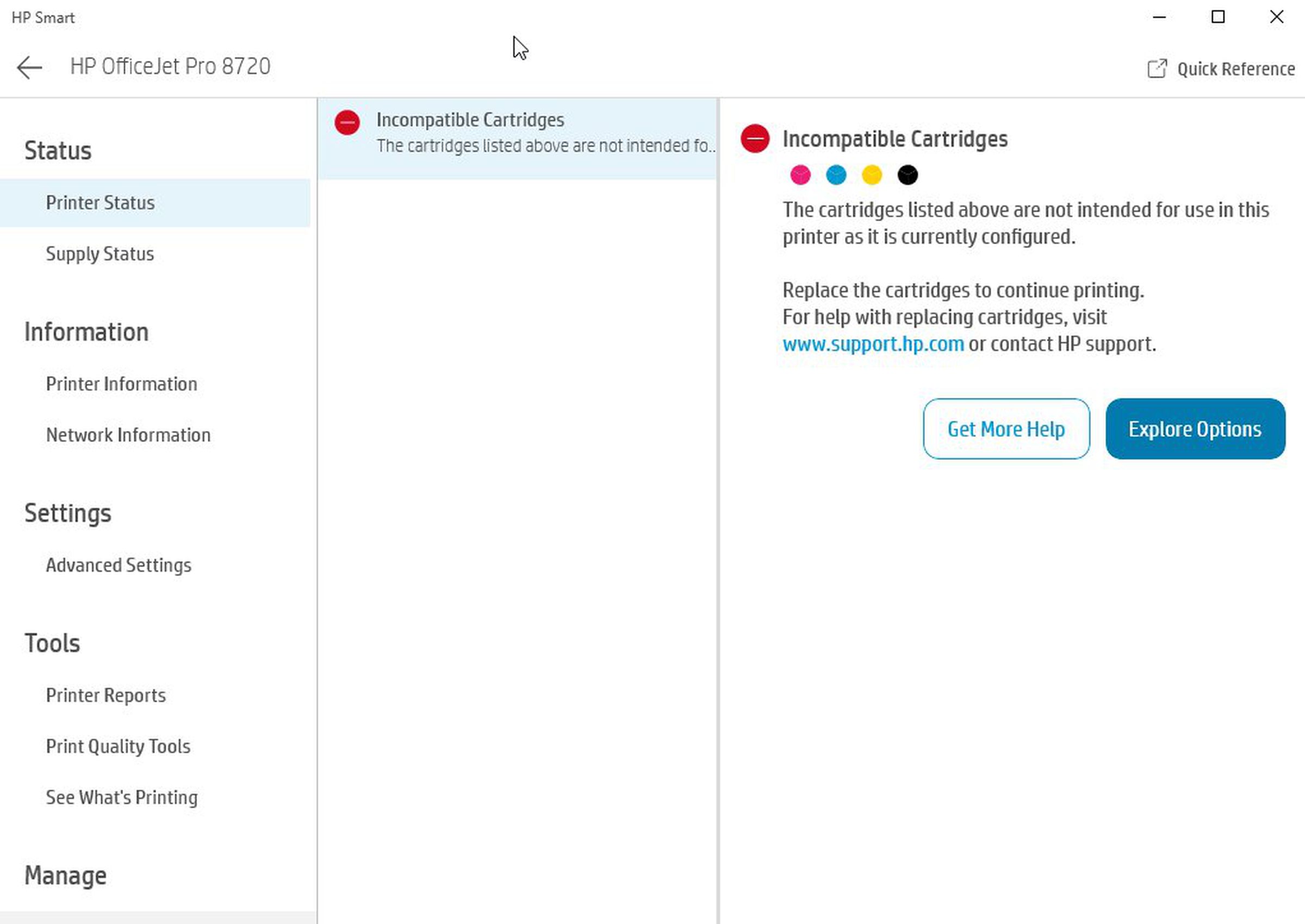
- I cannot access the secret menu in the ink levels menu in the HP Smart app because the ink cartridges are incompatible.
- HP Support asks for my printer serial number and suggests that I download the full HP printer software, rather than HP Smart, and try again.
- I download and install the full HP printer software. I open it. The software suggests that I use the HP Easy Start utility.
- I install the HP Easy Start utility.
- The HP Easy Start utility downloads and installs the full HP printer software.
- I run the software. It suggests that I use the HP Easy Start utility.
- I give up and try a different computer.
- I am able to access the secret Set New Region menu. This menu — which warns it’s supposed to be used in conjunction with support — lists the printer serial number, the total page count, something called an RX code, and the nine-digit serial numbers for each of the four cartridges. It has five text input fields at the bottom, labeled 41, 42, 43, 44, 45, and 51.
- Here is what’s supposed to happen: I give support the information above. Support plugs it into a key generation utility and generates five four-digit numbers. I plug those numbers into boxes 41 through 45, which generates a five-digit hash in box 51. I read that number back to support. If it matches the box 51 number in their software utility, I hit Reset Device, and the printer region resets.
- I send the serial numbers, page count, and RX code to HP Support via Twitter DM.
- It is revealed that either Twitter or the software HP uses to interact with Twitter DMs is redacting the serial numbers.

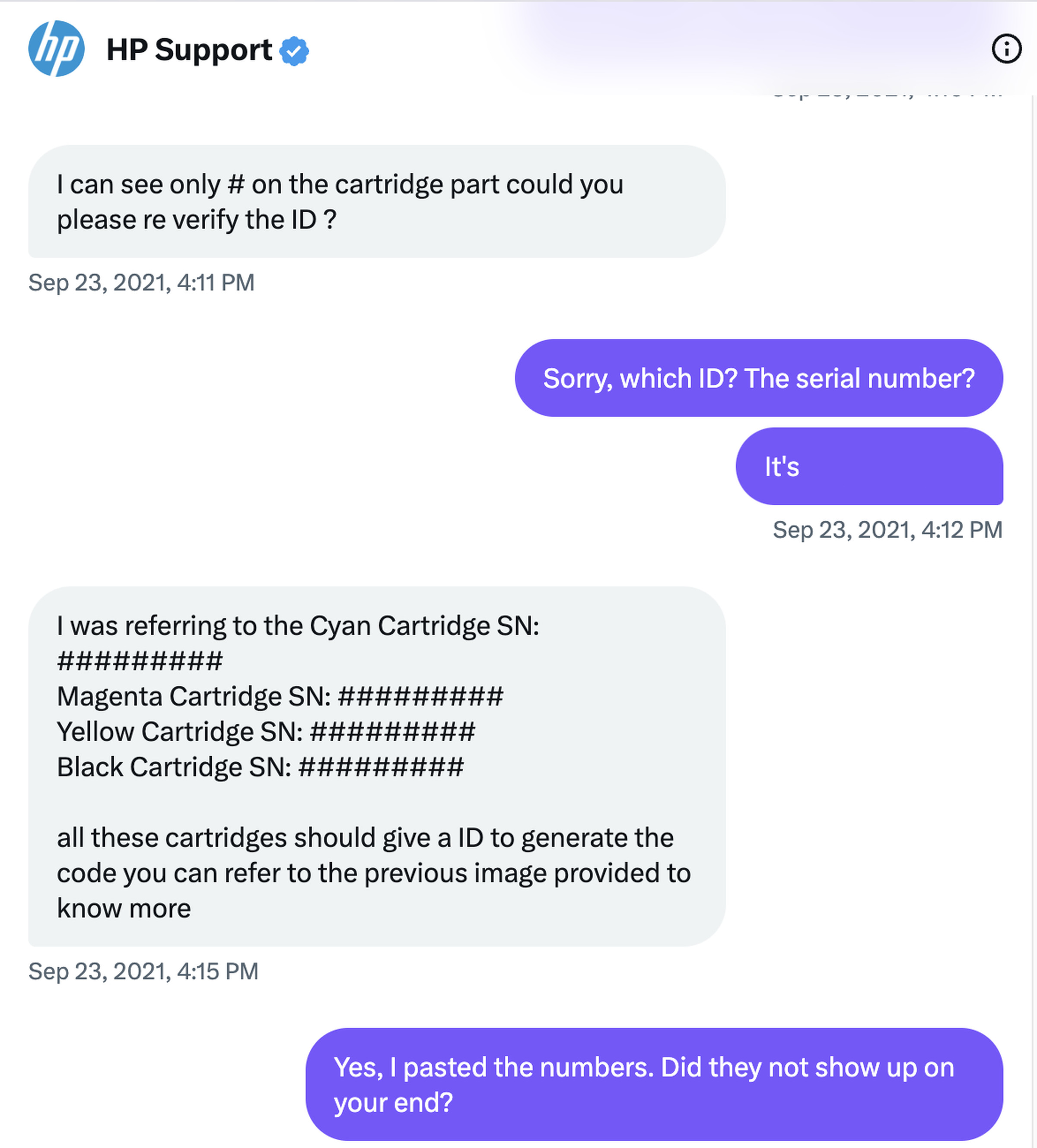
- I send a screenshot of the serial numbers instead.
- I send the serial numbers in plain text with spaces between the digits.
- The HP tech plugs the information into the reset utility. The utility gives an error.
- The tech says we’ve reached the limits of the help they can offer via Twitter DM and asks me to call the phone support team.
- It is 5PM. I have to pick up my kids from their after-school program.
- I bite the bullet and pick up the telephone. The first rep, who I’ll call Alice, points out that my printer is out of warranty. I agree but point out that the ink is still in warranty (a technique suggested by the posts I found online) and ask for a regionalization reset on the printer so I can use the ink.
- Alice does not know how to help. Since the problem is ink-related, she transfers me to the Instant Ink support line.
- Bertrand, the Instant Ink rep, tells me they cover ink, not printers, and transfers me back to the general support line. I have been on the phone for 45 minutes, which feels like a long time because I do not yet know what lies ahead.
- Cecile in general support gives me a phone number for the technical support line.
- Somewhere around here (my notes aren’t specific) someone asks for my street address.
- At the one-hour mark, Ferdinand from technical support suggests having a different team remote into my PC to run a local script to fix the printer. I decline. There’s no way in hell I’m letting someone remote into my computer, especially because the documented procedure for resetting the printer region doesn’t mention anything of the sort.
- At this point, I have to go to the grocery store. Ferdinand promises to call back.
- Five hours later, during dinner, I get a call back from Ferdinand. We spend one hour on the phone, during which I send them the serial numbers for my EU and US printer cartridges, they plug those into a software utility, and they send me a series of reset codes to try.
- My first indication that they are using the wrong utility is that they are asking for eight-digit serial numbers. My ink cartridges have nine-digit codes. I realize there may be different region reset utilities for different printer product lines.
- Ferdinand is adamant that it is the right tool. There are four possible printer zones, according to the software they’re using. Just for the hell of it, we try all four zones with both sets of cartridges. We try over USB and via an ethernet connection. I have pages of code variants in my notes. I dutifully plug in the numbers generated by the tool. Sometimes box 51 matches, sometimes it doesn’t. Either way, when I hit the Reset Device button, the operation fails.
- Ferdinand says that it may not be the right tool after all, but they don’t have access to any other tools.
- They advise me to call the technical support team at yet another phone number. It is bedtime for my kids. I call it a day.
(Two days later)
- I spend several hours on the phone with the technical team. They cannot generate a working reset code either and suggest a “semi-full reset” of the printer. I comply. It does not reset the printer region.
- They offer to send me a completely different printer, an OfficeJet 8210. It’s slightly slower and has half the print resolution, but even if it were better, my resolve is unwavering: this printer should work. I will not rest until it does work.
- My youngest kid gets sick, and a series of stressful events unfolds. I no longer care to pursue the printer situation.
- The following week, I borrow a working printer (an Epson inkjet I left behind when I moved to the Netherlands) from my mother-in-law and forget about the HP.
- Something annoys me about the Epson. I can’t remember what. Probably I am also procrastinating on a freelance assignment. I log back in to the HP website and generate a new support ticket. See you in hell.
- New case number in hand, I call HP Support.
- After navigating a byzantine phone tree, I am connected to someone who sounds like they’re standing on the side of a mountain during a windstorm. Neither of us can make out what the other is saying. I hang up.
- I call back. I endure the phone tree again. I am placed on hold. After a long time, the automated system hangs up on me.
- I call again. I finally reach a human. John really wants to fix this.
(n.b. The exact order of events here is a little fuzzy here because my notes are sparse.)
- We might be getting somewhere. John emails me a link to a webpage.
- The link is to a page on the HP Support internal site, which I cannot access.
- He sends me a second one. It is to a different page on the HP Support internal site.
- He sends me a third link. From the URL, it seems like it’s the actual keygen utility that generates the region reset codes. I can’t access it because it is on the HP Support internal site.
- John wants to see what’s going on with my printer. He asks to do a remote desktop session. We compromise on a video call from my phone. I point the phone at the region reset dialog so he can make sure he has the serial numbers typed down correctly.
- In addition to the printer serial number and the four nine-digit serial numbers of the cartridges, which I can get from the secret menu, he asks for a separate six-digit number that’s printed on each cartridge. Maybe this is the information that finally lets us access the correct key generation software.
- John plugs some numbers into the key generation utility. He gives me the five four-digit numbers for boxes 41 through 45. I plug them into the dialog box on my computer. A number appears in box 51.
- Box 51 matches the number John got from the utility. I try not to get my hopes up.
- I hit “Reset Device.” A dialog box pops up: Region Successfully Reset.

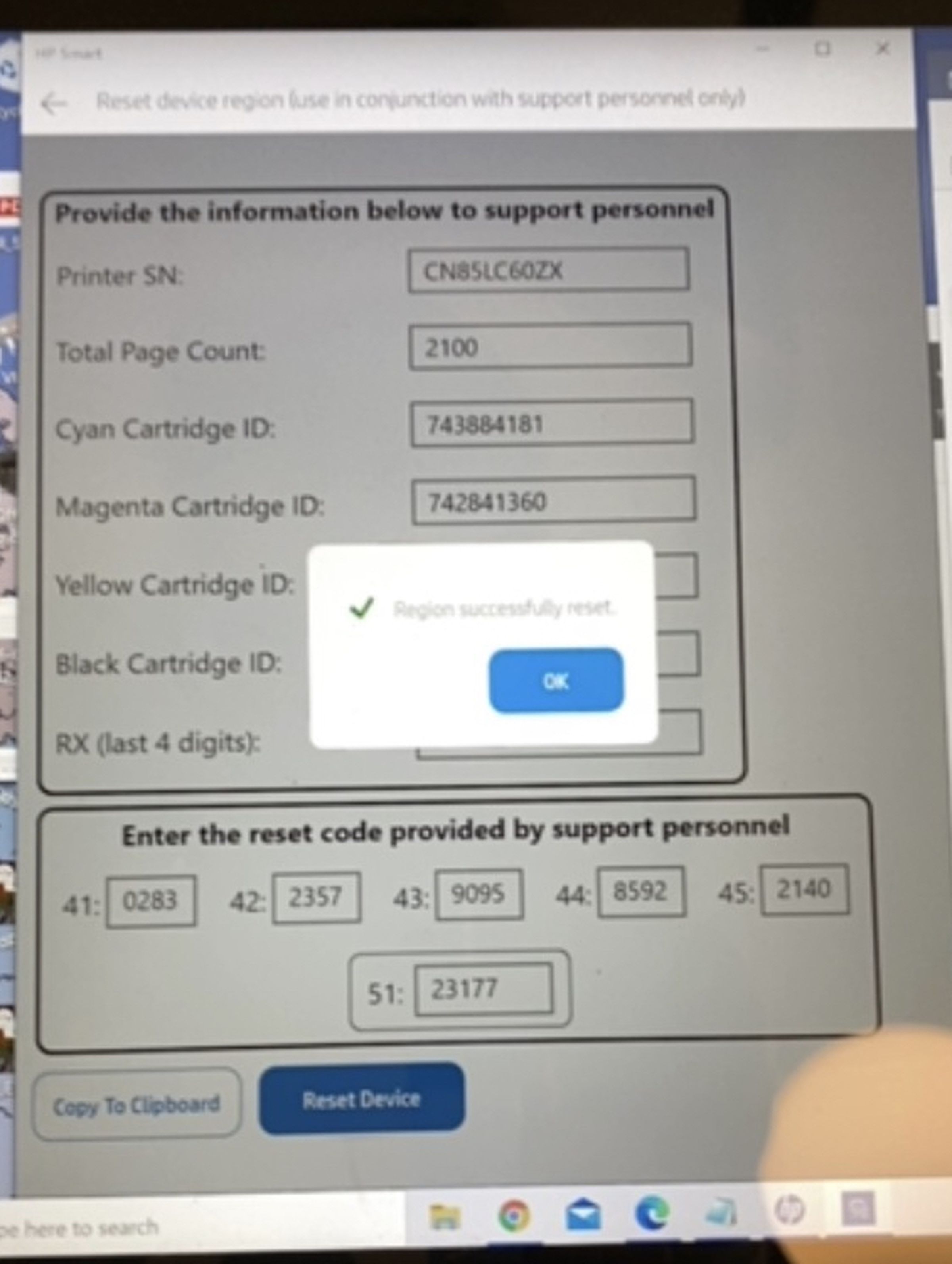
- John asks me to pull the plug on the printer, wait one minute, and turn it back on. He says if this doesn’t fix it, the problem is with the ink cartridges, not the printer. I am skeptical.
- I turn the printer back on. John asks me to print a test page.
- IT WORKS! Our long national ordeal is over and I can print again.
- I thank John profusely for his help.
- John tries to upsell me on an Instant Ink subscription. I decline.
- John asks if there’s anything else he can help me with. That’s it, man. We’re good.
- He asks for my mailing address, which I provide.
- I take the post-call survey. My praise for John borders on the effusive.
- I pick my kids up from daycare and take them to the playground. The February air tastes sweeter somehow.
- One week later, a padded envelope arrives from HP. It contains a free high-capacity black ink cartridge.
That was last February. The printer has been working fine since then. Until Nilay wrote his piece about the Brother laser printer, I hadn’t thought much about it, which is the ideal relationship between a person and their printer.
But the journey changed both of us. I can’t go back to the person I was in late 2021, and I think you can only reset your printer region three times. I didn’t add a working printer to the world’s growing pile of e-waste, but now I think I’m stuck with it until one of us dies.
The printer software estimates that I have 600 pages left on my cyan, yellow, and back cartridges and 800 pages left on magenta. That should last me a year or two. After that? I have that free black ink cartridge from HP, but high-capacity color cartridges are $40 a pop. Or, as the HP website cheerily points out, I could sign up for Instant Ink.
Respectfully: not a chance in hell.









